Page 43 of 460
Seat and restraint systems
2-17
2
3. Pull the seat belt out slowly while holding the latch plate.
Push the latch plate into the buckle until you hear a
“click”. Pull up on the belt to be sure the latch plate is
locked securely in the buckle.NOTE�If the seat belt locks up and cannot be pulled out, pull it
once with force and let it retract all the way.
Then, pull the belt out slowly once again.4. The lap part of the belt must always be worn low and snug
across the hips. Pull up on the shoulder portion of the belt
to take up any slack in the lap belt.
BK0162600US.book 17 ページ 2013年3月22日 金曜日 午後2時41分
Page 45 of 460

Seat and restraint systems
2-19
2
NOTE�If the seat belt subsequently remains unfastened, the
warning light and the tone will issue further warnings
each time the vehicle starts moving from a stop.
Front passenger seat belt warning light
N00418300237
The front passenger seat belt warning light is located at shown
in the illustration.
When the ignition switch is turned to the “ON” position or the
operation mode is put in ON, this indicator normally comes on
and goes off a few seconds later.
The light comes on when a person sits on the front passenger
seat but does not fasten the seat belt. It goes off when the seat
belt is subsequently fastened.
WA R N I N G
!�In order to reduce the risk of serious injury or death
in an accident, always fasten your own seat belt. Do
not allow anyone to ride in your vehicle unless he or
she is also seated and fastening a seat belt. Children
should additionally be restrained in a secure child
restraint system.
WA R N I N G
!�When a child booster seat is used on the front pas-
senger seat, the front passenger seat belt warning
light will not come on, if the seat belt is not fastened
when the booster seat is used. Confirm that the child
is wearing the seat belt properly.
BK0162600US.book 19 ページ 2013年3月22日 金曜日 午後2時41分
Page 47 of 460
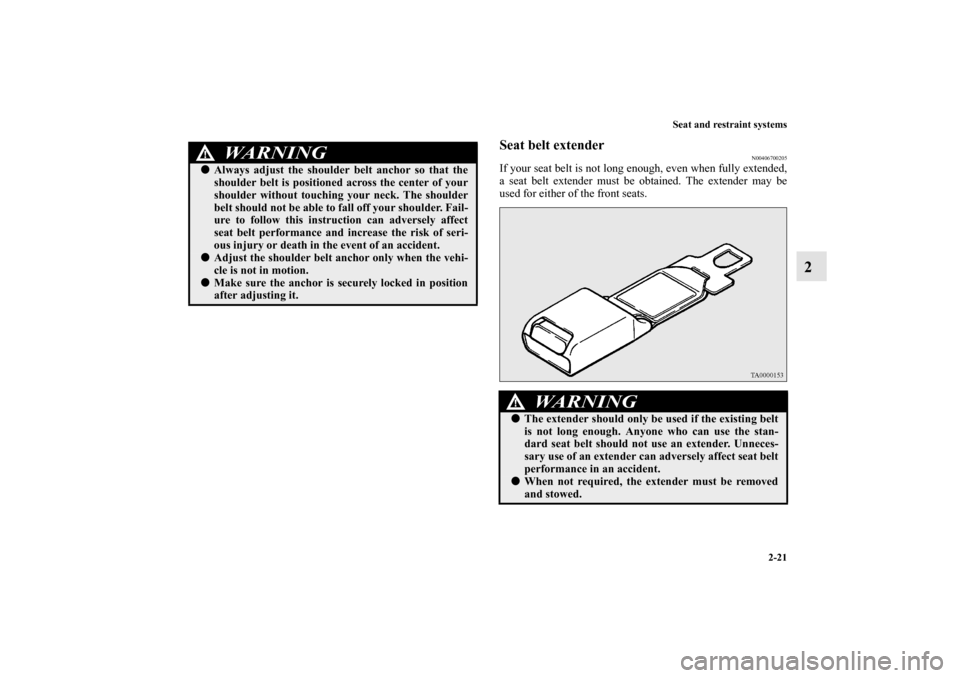
Seat and restraint systems
2-21
2
Seat belt extender
N00406700205
If your seat belt is not long enough, even when fully extended,
a seat belt extender must be obtained. The extender may be
used for either of the front seats.
WA R N I N G
!�Always adjust the shoulder belt anchor so that the
shoulder belt is positioned across the center of your
shoulder without touching your neck. The shoulder
belt should not be able to fall off your shoulder. Fail-
ure to follow this instruction can adversely affect
seat belt performance and increase the risk of seri-
ous injury or death in the event of an accident.�Adjust the shoulder belt anchor only when the vehi-
cle is not in motion.�Make sure the anchor is securely locked in position
after adjusting it.
WA R N I N G
!�The extender should only be used if the existing belt
is not long enough. Anyone who can use the stan-
dard seat belt should not use an extender. Unneces-
sary use of an extender can adversely affect seat belt
performance in an accident.�When not required, the extender must be removed
and stowed.
BK0162600US.book 21 ページ 2013年3月22日 金曜日 午後2時41分
Page 53 of 460
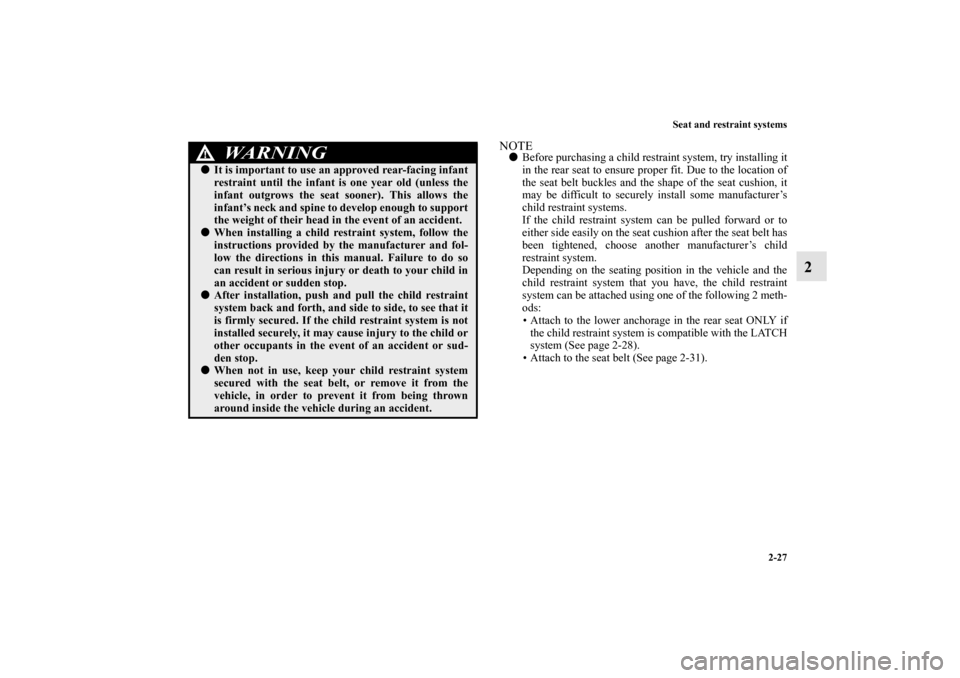
Seat and restraint systems
2-27
2
NOTE�Before purchasing a child restraint system, try installing it
in the rear seat to ensure proper fit. Due to the location of
the seat belt buckles and the shape of the seat cushion, it
may be difficult to securely install some manufacturer’s
child restraint systems.
If the child restraint system can be pulled forward or to
either side easily on the seat cushion after the seat belt has
been tightened, choose another manufacturer’s child
restraint system.
Depending on the seating position in the vehicle and the
child restraint system that you have, the child restraint
system can be attached using one of the following 2 meth-
ods:
• Attach to the lower anchorage in the rear seat ONLY if
the child restraint system is compatible with the LATCH
system (See page 2-28).
• Attach to the seat belt (See page 2-31).
WA R N I N G
!�It is important to use an approved rear-facing infant
restraint until the infant is one year old (unless the
infant outgrows the seat sooner). This allows the
infant’s neck and spine to develop enough to support
the weight of their head in the event of an accident.�When installing a child restraint system, follow the
instructions provided by the manufacturer and fol-
low the directions in this manual. Failure to do so
can result in serious injury or death to your child in
an accident or sudden stop.�After installation, push and pull the child restraint
system back and forth, and side to side, to see that it
is firmly secured. If the child restraint system is not
installed securely, it may cause injury to the child or
other occupants in the event of an accident or sud-
den stop.�When not in use, keep your child restraint system
secured with the seat belt, or remove it from the
vehicle, in order to prevent it from being thrown
around inside the vehicle during an accident.
BK0162600US.book 27 ページ 2013年3月22日 金曜日 午後2時41分
Page 54 of 460
2-28 Seat and restraint systems
2
Installing a child restraint system using the
LATCH (Lower Anchors and Tethers for chil-
dren) system
N00418800157
Lower anchor locationsThe outboard seating positions in the rear seat of your vehicle
are equipped with lower anchors for attaching child restraint
systems compatible with the LATCH system.
Tether anchor locations
N00418900190
Your vehicle has 3 attachment points on the back of the rear
seatbacks. These are for securing a child restraint system tether
strap to each of the 3 rear seating positions in your vehicle.NOTE�The attachments points are behind slits on the seatback
backboard cloth.
BK0162600US.book 28 ページ 2013年3月22日 金曜日 午後2時41分
Page 55 of 460
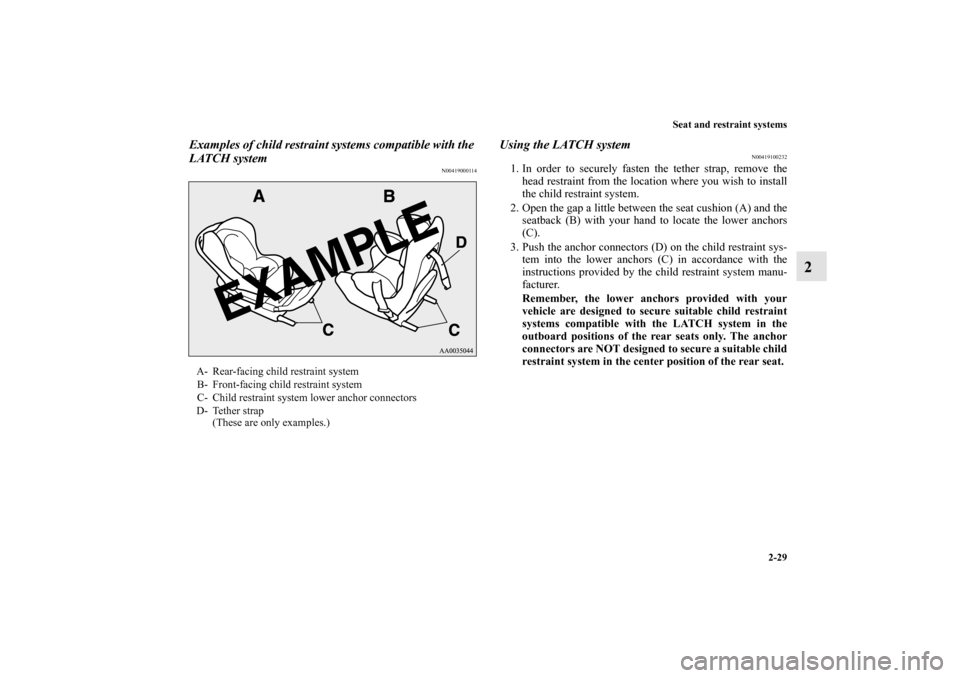
Seat and restraint systems
2-29
2
Examples of child restraint systems compatible with the
LATCH system
N00419000114
Using the LATCH system
N00419100232
1. In order to securely fasten the tether strap, remove the
head restraint from the location where you wish to install
the child restraint system.
2. Open the gap a little between the seat cushion (A) and the
seatback (B) with your hand to locate the lower anchors
(C).
3. Push the anchor connectors (D) on the child restraint sys-
tem into the lower anchors (C) in accordance with the
instructions provided by the child restraint system manu-
facturer.
Remember, the lower anchors provided with your
vehicle are designed to secure suitable child restraint
systems compatible with the LATCH system in the
outboard positions of the rear seats only. The anchor
connectors are NOT designed to secure a suitable child
restraint system in the center position of the rear seat.
A- Rear-facing child restraint system
B- Front-facing child restraint system
C- Child restraint system lower anchor connectors
D- Tether strap
(These are only examples.)
BK0162600US.book 29 ページ 2013年3月22日 金曜日 午後2時41分
Page 56 of 460
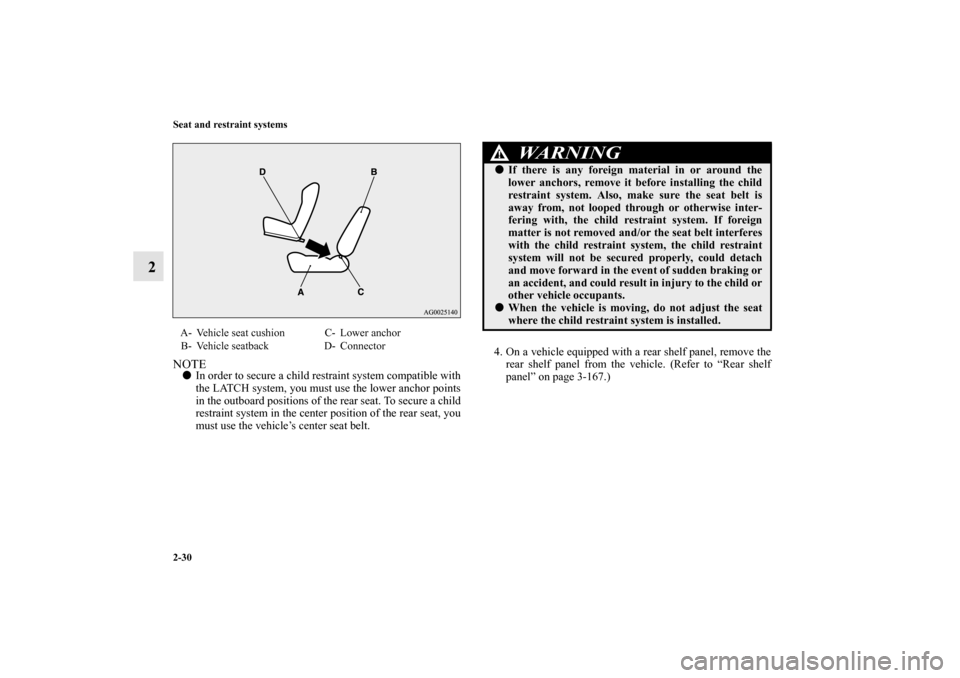
2-30 Seat and restraint systems
2
NOTE�In order to secure a child restraint system compatible with
the LATCH system, you must use the lower anchor points
in the outboard positions of the rear seat. To secure a child
restraint system in the center position of the rear seat, you
must use the vehicle’s center seat belt.4. On a vehicle equipped with a rear shelf panel, remove the
rear shelf panel from the vehicle. (Refer to “Rear shelf
panel” on page 3-167.)A- Vehicle seat cushion C- Lower anchor
B- Vehicle seatback D- Connector
WA R N I N G
!�If there is any foreign material in or around the
lower anchors, remove it before installing the child
restraint system. Also, make sure the seat belt is
away from, not looped through or otherwise inter-
fering with, the child restraint system. If foreign
matter is not removed and/or the seat belt interferes
with the child restraint system, the child restraint
system will not be secured properly, could detach
and move forward in the event of sudden braking or
an accident, and could result in injury to the child or
other vehicle occupants.�When the vehicle is moving, do not adjust the seat
where the child restraint system is installed.
BK0162600US.book 30 ページ 2013年3月22日 金曜日 午後2時41分
Page 57 of 460
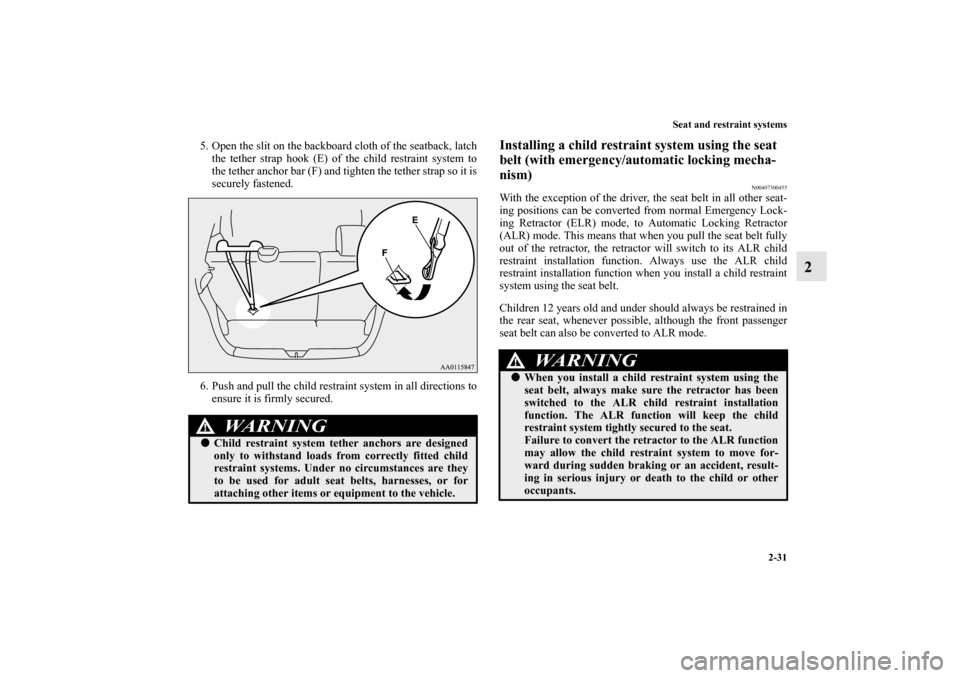
Seat and restraint systems
2-31
2
5. Open the slit on the backboard cloth of the seatback, latch
the tether strap hook (E) of the child restraint system to
the tether anchor bar (F) and tighten the tether strap so it is
securely fastened.
6. Push and pull the child restraint system in all directions to
ensure it is firmly secured.
Installing a child restraint system using the seat
belt (with emergency/automatic locking mecha-
nism)
N00407300455
With the exception of the driver, the seat belt in all other seat-
ing positions can be converted from normal Emergency Lock-
ing Retractor (ELR) mode, to Automatic Locking Retractor
(ALR) mode. This means that when you pull the seat belt fully
out of the retractor, the retractor will switch to its ALR child
restraint installation function. Always use the ALR child
restraint installation function when you install a child restraint
system using the seat belt.
Children 12 years old and under should always be restrained in
the rear seat, whenever possible, although the front passenger
seat belt can also be converted to ALR mode.
WA R N I N G
!�Child restraint system tether anchors are designed
only to withstand loads from correctly fitted child
restraint systems. Under no circumstances are they
to be used for adult seat belts, harnesses, or for
attaching other items or equipment to the vehicle.
WA R N I N G
!�When you install a child restraint system using the
seat belt, always make sure the retractor has been
switched to the ALR child restraint installation
function. The ALR function will keep the child
restraint system tightly secured to the seat.
Failure to convert the retractor to the ALR function
may allow the child restraint system to move for-
ward during sudden braking or an accident, result-
ing in serious injury or death to the child or other
occupants.
BK0162600US.book 31 ページ 2013年3月22日 金曜日 午後2時41分